You know how they say it’s the little things that count?
Google agrees with that.
But you know how they also say don’t sweat the small stuff?
That doesn’t apply here.
Though some treat meta descriptions as an afterthought and others overlook meta description tags altogether (horrified eyebrows), a meta description is your 3-second elevator pitch that sells the wow-factor of your blog article. It’s what convinces someone to click your link over all the other links on their screen.
Plus, Google farts on you if you don’t have it.
So how do you write a meta description that wins clicks? With a fill-in-the-blanks formula we're happy to hand over.
That's how.
We'll also give you these golden goodies:
- The importance of page one
- The sad story of page two
- Google's no-wiggle room checklist
- How to add pizzazz to a 3-second pitch
- How to deliver on your landing page
- The best keyword tools
- Meta description examples that win
- Meta description do's and don'ts
- Meta description tips
- Rich results and schema markup — the spectacular parting shot.
Okay, let's play.
Get brand new SEO strategies straight to your inbox every week. 23,739 people already are!Sign Me Up
This is a meta description:

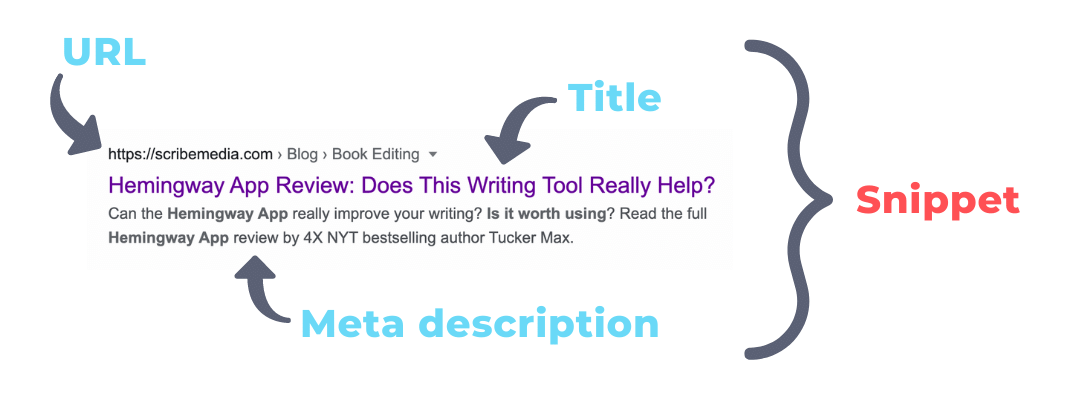
It’s the preview blurb under the page title that people see on Search Engine Results Pages (like Google Search and Bing Search). It describes what your content is about.
Google sees this tiny text blurb as a meta tag HTML attribute that describes webpage content. But humans read this as a mini advertisement that gives them a sneak peek into the answers they will find when they click your link—and jump to your landing page that answers their question in full.
Way hey.
What viewers see in SERP (the Search Engine Results Pages), is the book cover (title) and the back of the book (the meta description) along with the ISBN (the URL). Together, these three elements make what’s called a snippet.
The snippet either sells your destination (the click) or it doesn’t (no click).
You’re either Usain Bolt, or you’re a couch on a dolly pulled by a cardboard cut-out. You either win, or you lose a lot.
There’s a lot more losing than there is winning when it comes to meta descriptions.
Flumped.
Don’t worry, we’ll get to the winning formula in a minute. But first, let’s talk about why it’s worth dedicating 10 minutes of your life to writing a meta description.
Why bother doing anything on-page SEO-related? The answer is to get the best possible result.
Your meta description is a short commercial that convinces someone looking for your thing to click your ad out of the long list of ads. What you’re selling on SERP is an enticing preview of what promises to be a thrilling plot after the click (to your landing page).
The entire reason you bother writing a meta description is to get that click.
After the click, your on-page CRO (conversion rate optimization) takes over, giving your meta description a fist bump as the baton is passed.
But CRO doesn’t get that baton if the meta description trips at the starting line. The race starts with the snippet (page title + meta description).
So you need a warmup routine that guarantees an explosion out of the blocks when the gun goes off.
That’s what this post is about: writing a meta description with teeth.
But first, there are two things we want to drive home:
- If you don’t write the meta description, Google will auto-fill that space with a best guess description based on the content of your page. Bot-made descriptions don’t speak to your people the way you speak to your people. Random-grab copy sounds like robotic poop. Some people will click on robotic poop. More people will click on your personalized touch. And more clicks is the goal.
- Your meta description is an opportunity to catch your audience’s attention. Get creative. Flex your fingers. Have fun with it. Sit on the other side of the table and pretend you are your customer. What would you click? What things do you want to read before you click to read more? Write that. And write it so clearly that it shows up on page one in the SERP
Because only page one will do.
This is a sad short story.
Before someone thinks your meta description is so amazing they can’t help but click it, they have to see it first. It has to appear in front of their face in the list of options all flirting with their face already.
The only way that happens is if your meta description shows up on page one with a key phrase that matches the user’s search term (what they entered into the search bar).
Google highlights the keyphrase. That increases the odds of your meta description winning the click.
But remember: Google must think your description is amazing before people think it’s amazing.
What happens if you fail to impress Google?
You get bumped off page one.
What happens when you fall off page one?
You show up on page two.
Problem is, page two is the same as page 27. Which is the same as 2 million and seven—nothing much matters after you flush down Google’s “not page one” toilet to the URL dung heap.
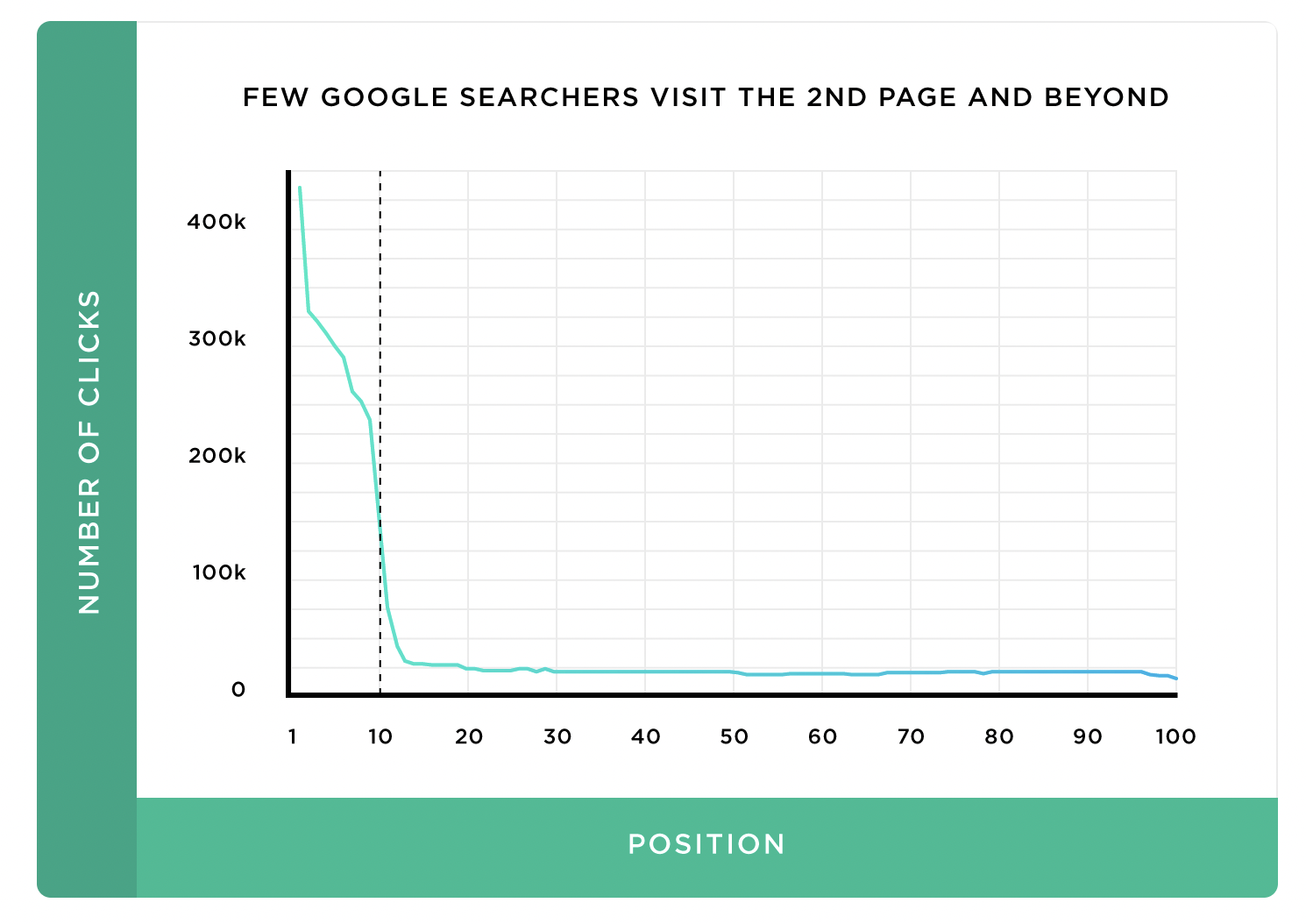
Put it this way:
If page one is prime ocean-front real estate, page two is a sad side road lot in the swamp. Nobody goes there on purpose (except to drop off a car chassis). So it’s important we follow the guidelines Google expects us to follow so we land on the coveted first page of SERP.
According to almighty Google, this is the checklist you should follow to get to page one.
- Make sure that every page on your site has a meta description.
- A meta description tag should inform and interest users
- It should be a short, relevant page summary (920 pixels or less)
- No duplication. Every meta description on your site should target a unique keyword (duplicate meta descriptions are penalized). You can use similar keywords, but not the exact same keyword. Differentiate the descriptions for different pages. Resist the urge to copy and paste a meta description to another page and change up one or two words. That doesn’t save time, it screws with your Search Engine Optimization (SEO). Google specifically warns against “duplicate or near-duplicate versions of your content across your site.”
- Include clear facts that wouldn’t appear in the snippet without focused attention: include price, age, and manufacturer for products and author, publication date, and byline for blogs or news articles.
Do these things and you’ll have a chance of appearing on page one for your targeted keyword.
But then—
That same meta description that won Google’s analytic heart must also show Google it has a tremendous flair for winning consistent clicks—by appealing to human eyeballs.
Remember, that’s the singular goal of your meta description: get visitors to click your link.
Google rewards clicks with sunshine and glitter (aka handsome Click-Thru Rate stats). But, lose clicks repetitively, and Google slides you off page one to you know where (Podunk Linksville, USA).
Note: Google doesn’t use the quality of your meta description as a direct page ranking factor. But Google does pay attention to CTR which does affect your rank. That makes your meta description an indirect contributor to your page rank position.
Now it’s time to figure out how to write your one-chance billboard for the traffic driving by—with a big-ass traffic-generating spotlight highlighting your meta description like the Hollywood sign.
How in the level heck do you write an elevator pitch with such 3-second pizzazz that it entices someone to click your link over all the other links competing in the SERPverse?
With a click-winning formula.
That’s how.
It starts by asking these two questions:
Google’s ranking algorithm does its best to offer the most relevant search results for a search query. It determines your ranking position by evaluating how well your content answers the searcher’s question. That’s why you give Google smoke signals that your content is a forking authority on the topic.
Knowing that...
Don’t ask: how do I rank for this keyword?
Ask this instead: How do I best answer my prospect’s question?
The Google search bots understand what your web page is about and maps semantic search results to user intent. Your user doesn’t intend to help you rank for a keyword. Your user intends to find an answer to their question.
Write a meta description that answers the question you think your audience will ask.
Be direct about that.
But absolutely go one step beyond the nuts and bolts with clever copy that catches their attention—add a hook. Because while you follow certain rules to make Google happy, you write the meta description to make people happy.
People are happy when you prioritize their user experience.
When scanning the list of meta descriptions on SERP, a good user experience is a meta description that reaches out and boops them on the nose with the answer—and potentially makes them smile.
The answer to their question informs the main focus keyword (and the list of semantically related keywords) you work into your snippet.
In case you fell off the turnip truck yesterday, pick a keyword your prospects search for that also has a high volume of search traffic.
When it comes to keywords, this is where gut meets science.
For the science bit, there are a lot of tools out there to help you find the perfect keyword. We wrote a post that breaks down our 30 favorite keyword research tools. But here's a quick list:
- Google Keyword Planner (free)
- Google Search Console (free)
- Google Trends (free)
- Google Suggest (appears when typing in google search bar)
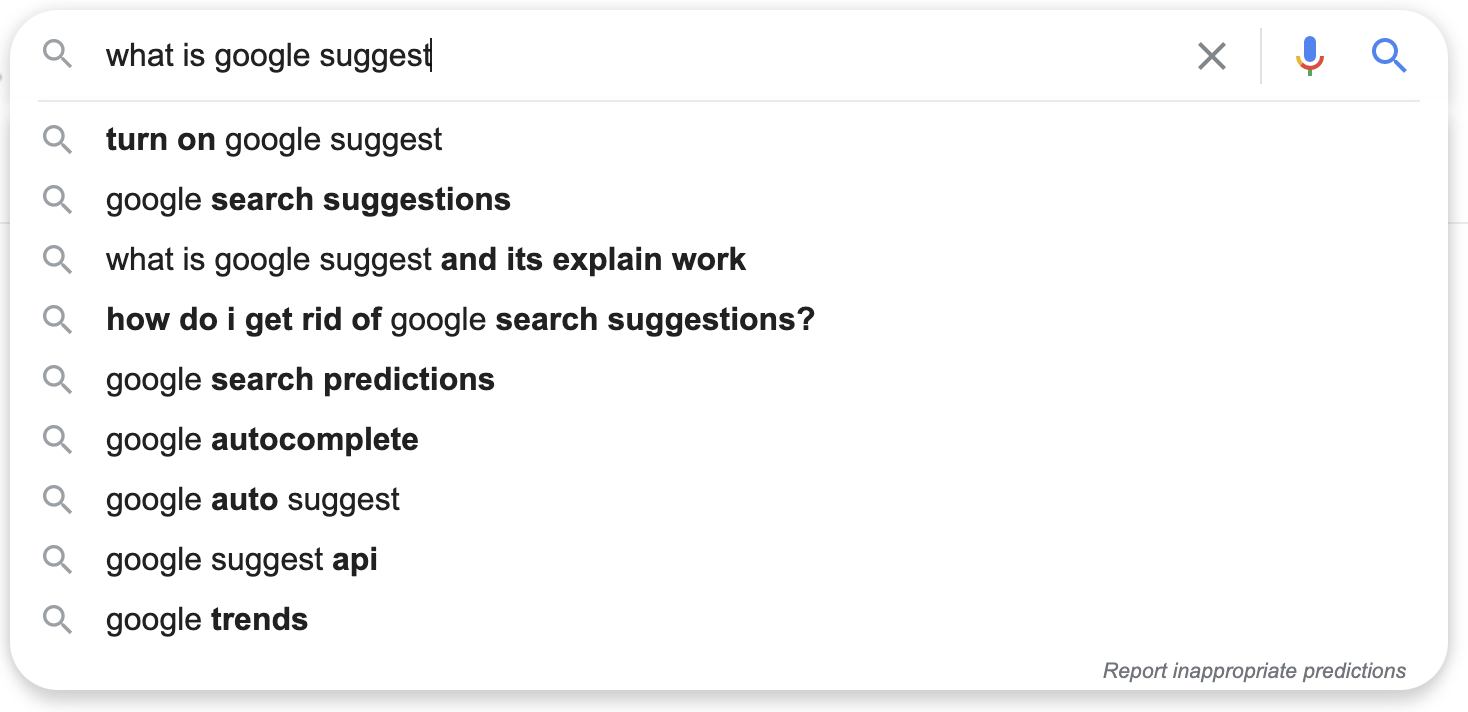
- Ahref’s Keyword Explorer (paid with free trial)
- SEMRush (paid with free trial)
- Moz Keyword Explorer (paid)
- Growthbar (paid with free trial)
- SpyFu (paid)
- KWFinder (paid with free trial)
Find your keyword, then take that keyword and make it the focus of your landing page (more on that below), page title, and your meta description.
You figured out the most likely search query and wrote a killer meta description—way to go. But now you have to make sure your landing page expands on what you promised to answer.
If your CTR is booming, but your landing page poops the shoot, Google will get a smelly heads up that you are not an authority on this topic; you simply duped some people into clicking a link that didn’t deliver.
There’s an orderly way to add keywords to your landing page—it isn’t a drunken blast of buckshot (so put away the 10-gauge, Cletus).
Add your focus keyword to your landing page like this:
- In your main header (H1)
- Once or twice in your subheaders (H2, H3, H4)
- Several times in your body copy
- In your image alt text
Okay, you’re ready.
You’ve got the moving parts down and now all you need is the color-by-numbers template to write meta descriptions that appear on page one and win all those lovely click click click click clicks.
Here we go.
This is a [what it is]. Learn how to [add the benefit] with this [describe it].
Simple as that.
Easy, right?
Well, yes if you know your best keyword (which Google highlights) and have a knack for writing catchy one-liners.
But maybe writing your meta description, even with our click-winning formula, doesn’t come easy.
No worries. We’ve got you, kindred spirit.
Here’s how you map things out until you get the hang of it. (And don’t be afraid to modify this template because uniqueness is greatness).
Let’s break down each component and then we’ll look at some examples.
Write for people, not search engines. Be conversational, concise, and compelling. Include the primary keyword your page aims to rank for—the keyword will be bolded if it matches the search terms queried.
Formula refresher:
This is a [what it is]. Learn how to [add the benefit] with this [describe it].
Let’s step through each of the three formula chunks that, when filled in properly, make a killer meta description.
Don’t spend a lot of time here. This isn’t complicated.
What is your page or post about? Make it easy on yourself by figuring out what the searcher’s query will be and answer that query right off the hop with the answer. That’s the [what it is]. If you make your page title the searcher’s question, make the meta description the answer.
Your customers have a pain point. They typed or spoke that pain point in the Google Search Bar to find the best solution to their problem. Your [what it is] caught their attention because their search term was highlighted in your meta description.
Now tell them what they’ll gain by clicking your link.
Will they learn something they need to learn? Will they get something they’re looking to get? Let them know their search is over. You’ve got them.
You have what they came looking for [what it is]. You’ve told them how clicking your link will solve their problem [add the benefit]. Now detail the “how.”
Is it a step-by-step walk-through? Can they book an appointment for a consultation? Is there a downloadable template or checklist?
Fill in those blanks and you’ve got a winning pitch. Let’s look at some examples:
This is a step-by-step guide to driving stick shift. Learn how to gear down like a champ with this video blog (plus blooper reel).
[what it is]: a step-by-step guide to driving stick shift
[add the benefit]: learn to gear down like a champ
[describe it]: with this video blog (plus blooper reel).
Length: 721 pixels
Looking for where to find purebred English Springer puppies? We’re registered breeders who have bred Springers since 2005. Book an appointment.
[what it is]: where to find purebred English Springer puppies breeders
[add the benefit]: registered breeders since 2005
[describe it]: Book an appointment.
Length: 855 pixels
Want to write the perfect marketing email? Nail it every time, get more clicks, and make more money with this downloadable checklist.
[what it is]: a how-to for writing the perfect marketing email
[add the benefit]: more clicks and more money
[describe it]: downloadable checklist
Length: 768 pixels
Pssst. If you actually do want to learn how to write the perfect marketing email check out our blog post that critiques 50 email marketing examples.
Meta descriptions made easy. Use KlientBoost’s simple, proven formula to increase your click-thru rate (CTR) and win new fans—Google approved.
[what it is]: how to write meta descriptions
[add the benefit]: higher CTR, more subscribers
[describe it]: a simple, proven formula that makes it easy
Length: 849 pixels
Catching on? You bet your butt you are.
Now let’s look at some real-life examples.

Search term: What is Uber Eats?
Google highlighted the parts of the search term that matched the meta description (uber eats).
[what it is]: a food delivery service branching off of Uber
[add the benefit]: food is delivered directly to your door.
[describe it]: place restaurant orders using the app

Search term: Is WeTransfer free?
Google highlighted WeTransfer and free.
[what it is]: the simplest way to send files
[add the benefit]: share files up to 2GB in size
[describe it]: free app
Plus, there are rich results at the bottom that make this snippet even more helpful. More on rich results later.

Search term: Should I use the Wave Accounting app?
Google highlighted Wave Accounting, use, and application.
[what it is]: an accounting application
[add the benefit]: easy to use, double-entry
[describe it]: designed for small businesses and freelancers.
Look at all of the rich results on this snippet. There’s even a review. Hold your horses on the rich results because we cover that later.
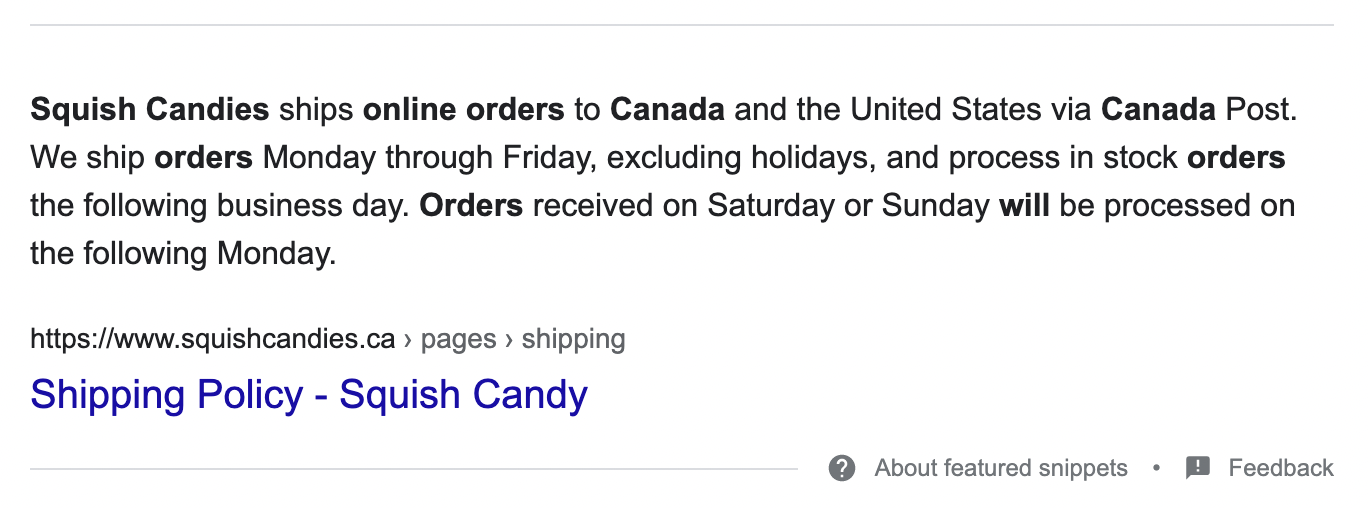

Crikeys. What’s going on here?
Something special that’s for sure. Let’s start with the usual critique:
Search term: Can I order Squish candies online?
Google highlighted Squish, candy, and candies.
[what it is]: gourmet candies
[add the benefit]: candy for all tastebuds, perfect for your candy bar
[describe it]: sweet, sour, vegan, traditional, cocktail gummies
Okay, now let’s talk about all the extras in this snippet.
Apart from links that take me to the order page for specific artisanal flavors, this listing won a coveted Featured Snippet result that better described how online orders work, where orders ship to, and on what schedule.
Mind is blown.
Don’t pee your pants, but we’re not at the rich results section yet.
Before we get there, let’s do you one better with some meta description tips.
Here’s where we take a really good meta description and make it great. Observe.
The debate is out whether power words are powerful anymore. A few years ago, incorporating power adjectives worked. But now we’re growing increasingly immune to words that come off as clickbait. Today, coming in over the top might negatively impact your CTR by as much as 15%.
They’re meant to trigger emotional responses, but we are growing tired of them. Some of them are effective because they aren’t way over the top—words like easy, free, simple, best etc. But you’ve no doubt waded through this sort of word tripe before:
- Top Secret
- Little known
- Ultimate
- Myths
- Magical
- Insane
- Astonishing
- Urgent
- Shocking
If you use any of these jazzy pseudo-truths, you’ll get an eye roll and miss that click opp.
Newsflash: What you’re selling isn’t penultimately magical. Nor is your secret sauce protected by Fort Knox in an invisible room flanked by twinning unicorns.
You put your gold-studded pants on one leg at a time like everybody else.
Be honest with your fans.
Is there an optimal meta description length?
Yes.
Technically, a meta description can be as long as you like. Practically, don’t ramble on.
Google bases meta description lengths on pixels.
The limit on desktop is 920 pixels (approximately 155 characters), and 680 pixels on mobile (roughly 120 characters)—give or take a few pixels depending on the device.
Since only a certain number of pixels are viewable, it doesn’t make sense to hide some of your message behind a curtain. Focus less on the length and more on the value, to be sure. But mind that your description doesn’t suffer the telltale sign you’ve written too much: the cut-off ellipses (...).
If you use WordPress, you can upload an SEO plugin like Yoast to automatically check the length of your meta description and warn you if you forgot to add your keyword.
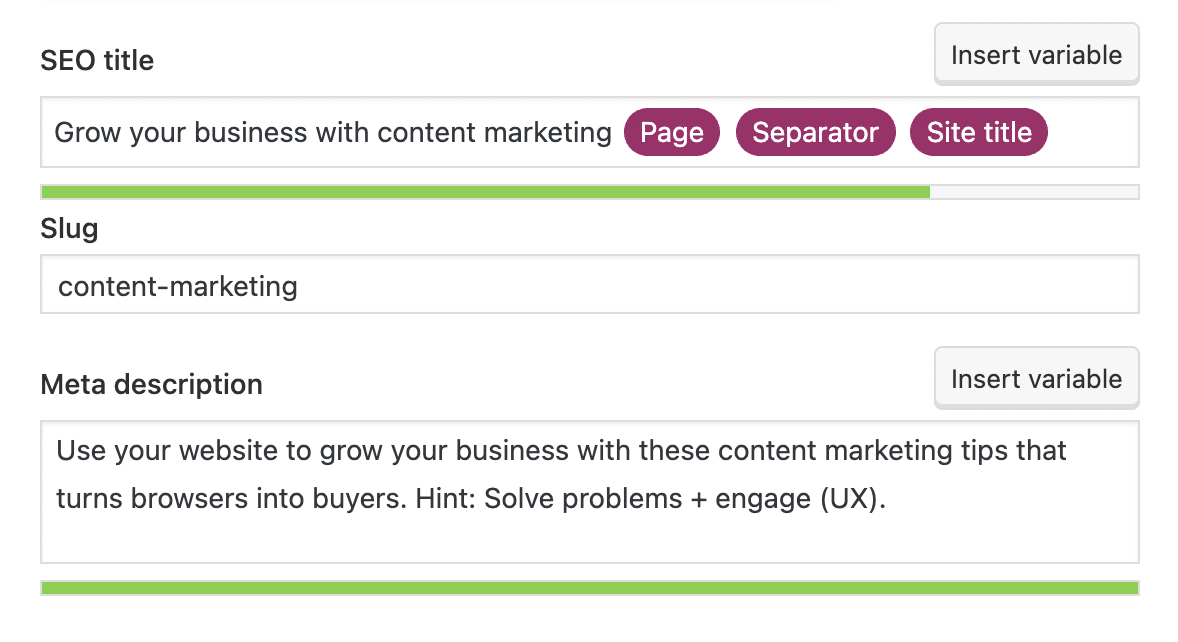

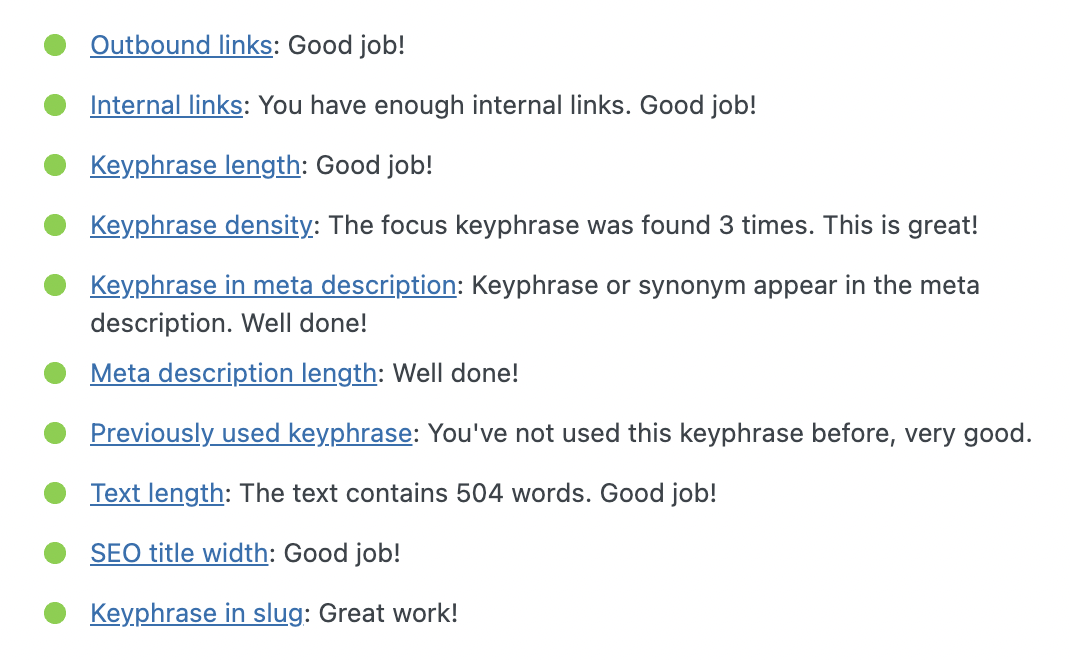
If you don’t have a WordPress site, or you’re looking for a quick and easy CMS-independent way to check your meta descriptions, use the SERP Snippet Preview Tool from To The Web.

Second-guessing?
Don’t let imposter syndrome get you down, rock star. But also, don’t be afraid to look at what others are doing.
Copy the descriptions you see in Google Ads for your own snippet. Google Ad placements are based on bids and Quality Score. If an ad scores high, the advertiser pays less per click than ads with low Quality Scores.
Guess what impacts Quality Score?
Click-through rate.
When you see a search ad, you know it has a high CTR—it’s getting clicks. That means you have an example of a meta description that’s working.
Cross-reference keywords that appeal across multiple ads. That repeating theme is ripe for the picking (and by that we mean stealing). Work those words into your meta description—but make it your own and make it compelling with your own spin.
Speaking of Google Ads, why do they always out-rank organic search results? That hardly seems fair.
The short answer is that Google needs to make money and ads are how that money is made.
But don’t be discouraged.
Those ads might win the first four spots on the SERP, but your searchers appreciate what they are and may or may not click them.
We’re becoming savvier.
We may skim the top-spot Google Ads before we scroll down to the organic search results—and sometimes those ads might win the click. But we might also bypass the paid ads, scrolling quickly down to where the organic snippets start.
Why?
Because we know that the organic results earned their spot on page one because of things like great meta descriptions that point to awesome landing pages. They moved to page one over time because they were optimized so well that people clicked on them more than any other URLs.
The paid ads win their spot with money.
Anyone with a figurative fiver can show up in numero uno. But that doesn’t mean you’ll find what you’re looking for if you click that paid link.
Maybe you don’t mind skipping past the dudes in the fancy tracksuits to get to the barefoot athletes ready to smoke them in their heats. Truth is, the barefoot athletes beat the fancy tracksuits 72% of the time.
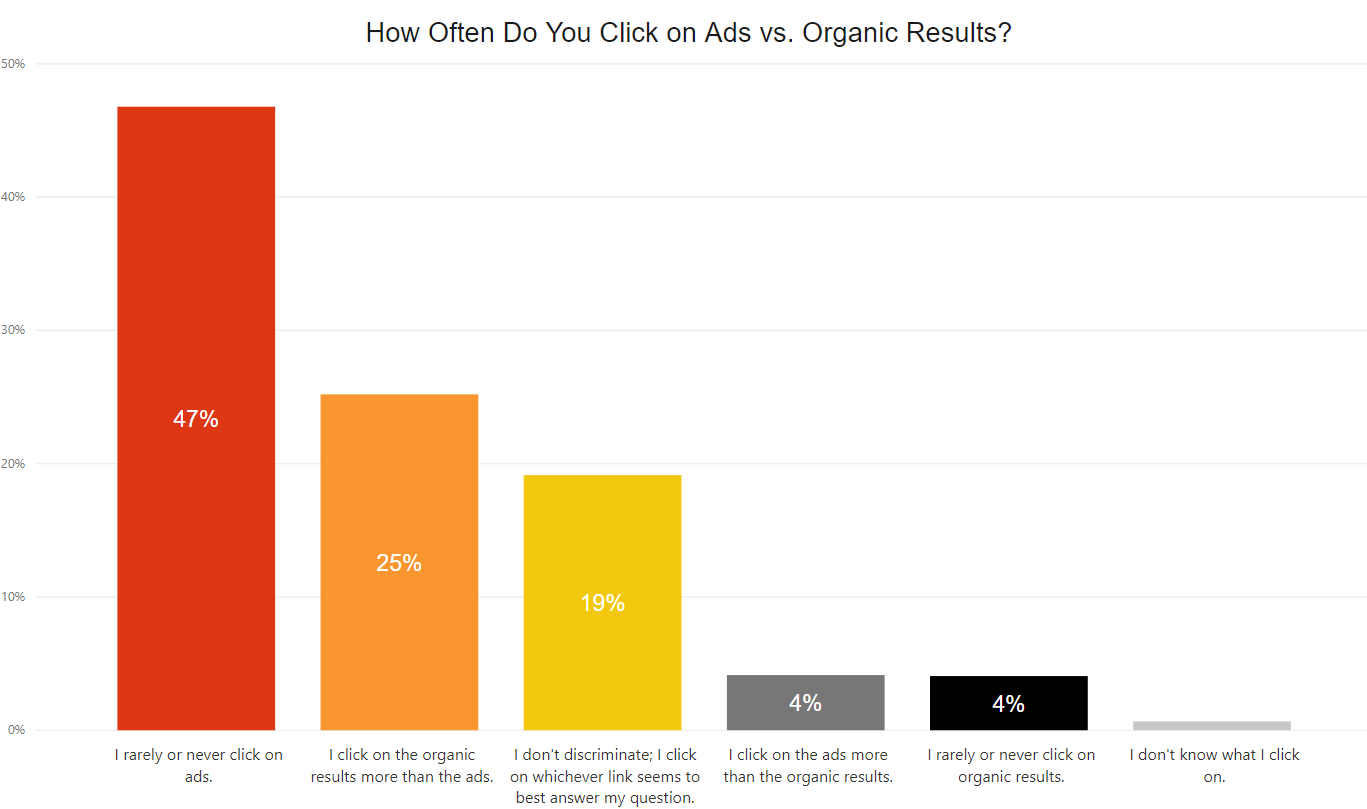
How do you like dem apples?
So write your meta descriptions like the meta mutha description writer you are. And if budget allows, put some money down on a Google Ad to cover your bases.
Meta descriptions aren’t afterthoughts. They are small but they pack a persuasive punch in a tightly written script. They have to be pretty fantastic to stay on page one—which is where all the cool kids hang.
And by cool kids, we mean companies who make money.
Fantastic means impressing Google and impressing humans. We suggest fantasticizing your meta descriptions by using the KlientBoost meta description formula to nail what it is, why it’s a benefit, and how it works. Every single time.
Write descriptions that outline the clear answers you’re serving up.
Tell users exactly what they’ll get and exactly what to do next. Create skimmable value with a clear benefit.
Work that keyword, baby.
It is more important than ever to include the most relevant keyword phrase or page topic at the beginning of your title tag and meta description attributes tag. The closer you put your keyword to the beginning of your description, the better.
Write your description first. Then check it for length and quality. If it’s too long, use smaller words and symbols (&, #, $, and %). Make words into contractions (like don’t, won’t, isn’t).
There’s no shame in being observant. Check out what’s working in the paid ad snippets. Take healthy queues from them. Roll those elements into your own meta descriptions.
You’ve just read 4000 words talking about how important meta descriptions are. If you decide not to write one or forget to write one, that will hurt our feelings.
Just kidding. We’ll think you’re dumb.
Deliver on your promise. Make sure your landing page matches your meta description. Make the baton pass a smooth hand-off.
Make your 920 pixels powerful without excessive use of over-the-top adjectives that turn your helpful description into a cheesy infomercial.
You can’t very well sound clever if your meta description is a stuffed sack of sh*t. Besides, repeating keywords comes with penalties. Stay away from keyword stuffing because that hasn't worked since before some of you were born.
Stay under Google’s 920-pixel character limit (680 pixels on mobile). There’s no penalty for writing a long meta description, but humans can only read the first 190 pixels (and Google doesn’t use the meta description for rank).
Writing buried copy is a waste of your time.
Do keep this in mind though: Google bolds the keywords that match the words in the search bar. If you’ve done a great job, you’ll have many bolded words.
But bolded words take up more space.
But bolded words take up more space.
That means your meta description might truncate because you did such a dang good job of hitting the search spots, your bold-heavy copy pushed over the maximum pixel count.
Copying the same meta description for more than one page or post confuses search engines and dilutes your value.
Sometimes a snippet gets special attention and that snippet gets “featured.”
Google highlights some snippets when it feels that snippet best relates to a user’s search. There are two ways to get Google’s eyes on your prize and win the coveted featured snippet preview:
- meta descriptions
- structured data
You already know how to turbocharge your meta descriptions with a proven formula. Now let’s turn our eyes for a moment on structured data.
Structured data are information bits you highlight in your page code to help Google better understand the content. When Google understands what your page is about, you have a higher chance to rank on page one in search results.
You’ve probably heard of schema markup?
Schema markup in structured data. The idea behind schema is that you mark up different elements of your site using raw HTML code or a plugin like Schema App Structured Data. You do this to make it easy for Google to assess the usefulness of your site.
- Recipe markup (prep time, cook time, ingredients, nutrition info, review)
- Organization markup (business name, logo, social)
- Person markup (name, age, education, family)
- Local Business markup (location, phone, email)
- Product & Offer markup (name, price, availability, SKU)
- Breadcrumbs markup (the URL path that leads to your page from the home page)
- Article markup (headline, author, publish data of blogs and news articles)
- Video markup (name, description, date, URL, duration, thumbnail)
- Event markup (name, date, location, price)
- Reviews
- FAQs
The point of a schema markup is to help searchers get answers to their questions directly on the search results page (SERP) without having to click through to your URL to track down that answer.
But… don’t we want that click?
Yes.
This is a double-edged sword.
Structured data has unsettled marketers because rich results in SERP cannibalize traffic to sites. Rich results give searchers no-click answers. Extremely beneficial for the searcher, but not so wonderful for CTRs. These search enhancements are called “position zero” and they mean less organic traffic for everyone.
- Paid SERP Ads
- Featured Snippets
- People Also Ask boxes
- Knowledge Panels
- Google maps
- Images.
“It is now even possible to browse flights, hotels, jobs, events, and other searches that were previously only available via external websites, directly on Google.” Moz
What is the lesson here?
The answer to that is: don’t compete with structured data.
Adapt by adopting what’s working.
Sure, adding structured data to your site takes more work. But nothing worth doing ever comes easy, so buck up buttercup and roll up your sleeves.
Do you sell products?
Add product schema markup for your gadget (price, size, manufacturer, etc.).
Here’s an example of an Apple Watch snippet that incorporates product-specific links to buy. If, as the searcher, all I was after was the price, I got what I came looking for in this example, and I don’t need to click the link. But if I saw the price and decided I want to buy the Series 3, that Buy Apple Watch Series 3 link is going to get my click.

So don’t muddle about and watch your snot drip on your shirt.
Add that schema markup and let your chest puff out.
Nail your meta descriptions and download a schema markup plugin to tell Google specifically why your page deserves to rank. Cross your fingers that you’ll appear as a featured snippet for certain search terms, and head out for dinner knowing you rocked not only your meta descriptions but the other stuff that makes for a brilliant snippet.
Before you go, one last heads up.
Google ultimately controls the search results. These results dynamically change based on individual search queries. In some unpredictable cases, search engines might decide not to use your meta description if the engine doesn’t think your description answers a user's query satisfactorily.
What can you do?
Your best is always the answer.
Shrug off the unknowns and level up where there’s levelling up to be had.
Design your tiny but brilliant billboard that will flag searchers off the highway to your roadside shop.
The powerful meta description has a lot of potential when it comes to optimizing user experience before searchers even get to your site.
Meta descriptions are the first impression.
But, with search, there aren’t many second shots.
If you follow our formula and mine some solid keywords, you’ll start to see more organic traffic over time.
And if you use structured data elements to position your brand strategically, you’ll stand out even more to both Google and your searchers.
Okay, drop the mic now and walk off stage (to applause).
Do you have a tried and true tactic you use to improve your meta description CTRs? Share it with us.